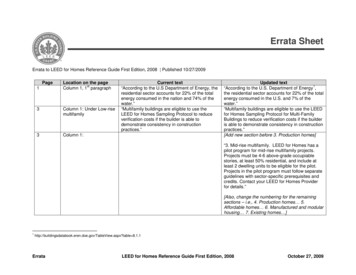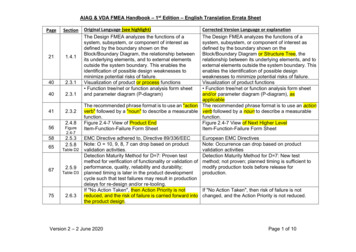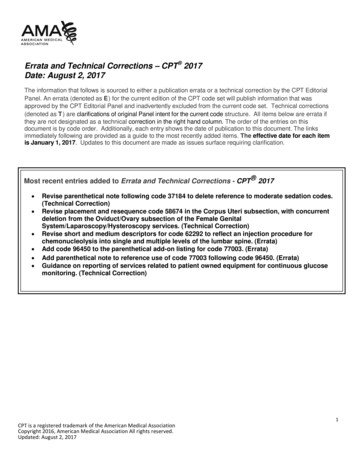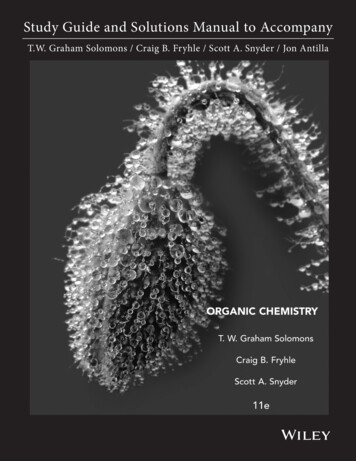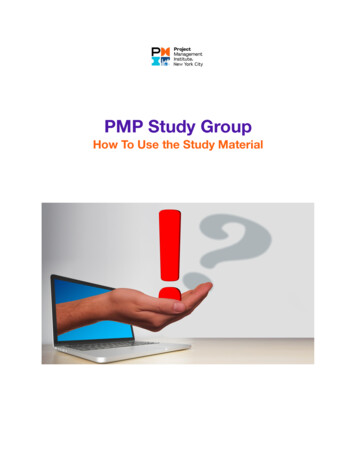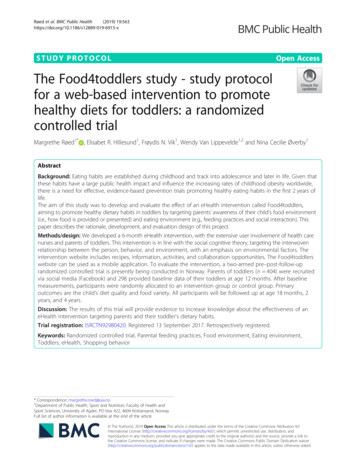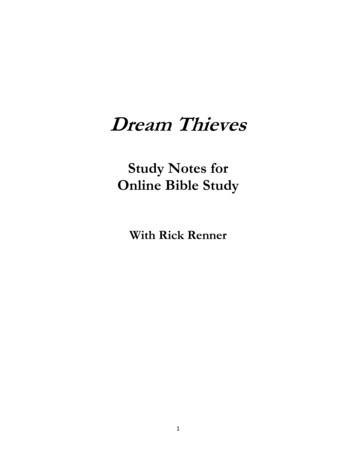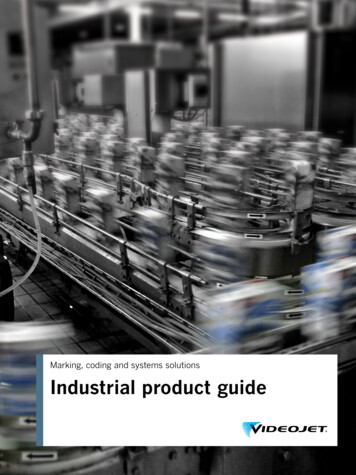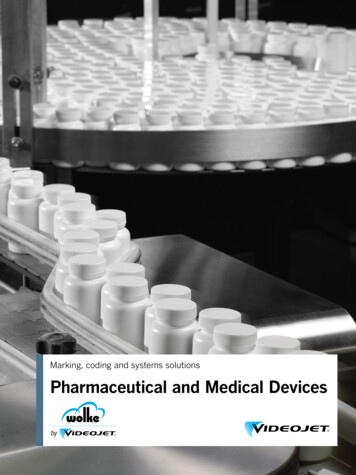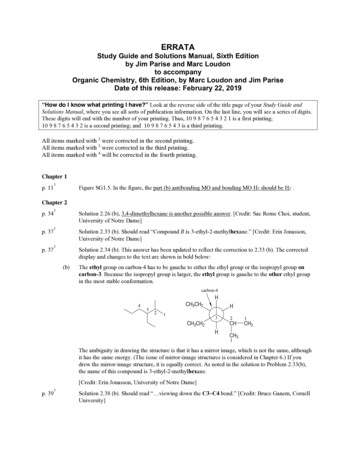
Transcription
ERRATAStudy Guide and Solutions Manual, Sixth Editionby Jim Parise and Marc Loudonto accompanyOrganic Chemistry, 6th Edition, by Marc Loudon and Jim PariseDate of this release: February 22, 2019“How do I know what printing I have?” Look at the reverse side of the title page of your Study Guide andSolutions Manual, where you see all sorts of publication information. On the last line, you will see a series of digits.These digits will end with the number of your printing. Thus, 10 9 8 7 6 5 4 3 2 1 is a first printing;10 9 8 7 6 5 4 3 2 is a second printing; and 10 9 8 7 6 5 4 3 is a third printing.All items marked with 2 were corrected in the second printing.All items marked with 3 were corrected in the third printing.All items marked with 4 will be corrected in the fourth printing.Chapter 13Figure SG1.5. In the figure, the part (b) antibonding MO and bonding MO H2 should be H2–.p. 11Chapter 23p. 34Solution 2.26 (b), 3,4-dimethylhexane is another possible answer. [Credit: Sae Rome Choi, student,University of Notre Dame]3p. 37Solution 2.33 (b). Should read “Compound B is 3-ethyl-2-methylhexane.” [Credit: Erin Jonasson,University of Notre Dame]3p. 37Solution 2.34 (b). This answer has been updated to reflect the correction to 2.33 (b). The correcteddisplay and changes to the text are shown in bold below:(b)The ethyl group on carbon-4 has to be gauche to either the ethyl group or the isopropyl group oncarbon-3. Because the isopropyl group is larger, the ethyl group is gauche to the other ethyl groupin the most stable conformation.The ambiguity in drawing the structure is that it has a mirror image, which is not the same, althoughit has the same energy. (The issue of mirror-image structures is considered in Chapter 6.) If youdrew the mirror-image structure, it is equally correct. As noted in the solution to Problem 2.33(b),the name of this compound is 3-ethyl-2-methylhexane.[Credit: Erin Jonasson, University of Notre Dame]p. 393Solution 2.38 (b). Should read “ viewing down the C3–C4 bond.” [Credit: Bruce Ganem, CornellUniversity]
Sixth Edition Study Guide and Solutions Manual Errata, January 6, 2018, p. 2Chapter 33p. 66Solution 3.53. The figure and caption to which this problem references is missing. It is shown below.Figure SG3.2 Free-energy diagram to accompany the solution to Problem 3.53. The dication isdestabilized by the two nearby positive charges. (The neutral compounds, are arbitrarily placed at thesame energy for comparison purposes.)Chapter 42p. 84Solution 4.8, parts (c) and (d) should be switched. Part (c) should begin “The prefix “cyclo” ” andpart (d) should begin “The suffix “triene” ”.3p. 85Solution 4.10 (a). Depending on which printing of the textbook you have, formula D may or may notbe reasonable. The answer should read:(a)A way to tell whether a formula is reasonable is to calculate its unsaturation number using Eq. 4.7 ontext p. 144. A formula that gives a negative or fractional unsaturation number is not possible.Formula A cannot be a correct formula, because a compound containing only C, H, and an oddnumber of nitrogens must have an odd number of hydrogens. Formula C also could not be theformula of an organic compound, because the maximum number of hydrogens possible in acompound containing 10 carbons, 3 nitrogens, and any number of oxygens is 25. Formulas B(C10H20N2O2) and D (C10H16O2) are both reasonable, and could be organic compounds.An early printing of the text had a formula D that was the same as formula A (C H N ),which would make it unreasonable.103p. 85203Solution 4.10 (b). There are nine isomeric alcohols with the given formula. The answer should read:(b)There are nine isomeric alcohols and one ketone with the formula C4H8O. The first three alcoholsare called enols and, as you will learn in Chapter 14, they are in equilibrium with their correspondingketone or aldehyde forms.
Sixth Edition Study Guide and Solutions Manual Errata, January 6, 2018, p. 3[Credit: Meridith Balbach, student, University of Notre Dame]4p. 90Figure SG4.1. The curves are mislabeled; “reaction A” and “reaction B” should be switched. [Credit:Maggie Doyle, student, University of Notre Dame]3p. 95Solution 4.46. The answers to parts (b) and (d) should be switched. Part (b) should be (E)-4,4,dimethyl-2-pentene and part (d) should be 4-methylcycloheptene. [Credit: Roslyn Joseph, student,University of Notre Dame]3p. 97Solution 4.52. The cis isomer of the second compound shown is also a correct answer. The updateddisplay is shown below.2p. 1002p. 101Solution 4.61 (c). The last line should read “ by between 14.2 and 6.6 kJ mol—1”.Figure SG4.6. The second value, between 2-methyl-1-butene and 2-methyl-2-butene should be –6.6kJ mol—1, not –14.2. The corrected figure is shown below.Chapter 53p. 123Solution 5.4 (d). In the product, the last carbon in the chain should be CH3, not CH2. [Credit: LeighCampbell, student, University of Notre Dame]
Sixth Edition Study Guide and Solutions Manual Errata, January 6, 2018, p. 4p. 12443p. 1243p. 1274p. 1292p. 134Solution 5.7 (d). In the product, the last carbon in the chain should be CH3, not CH2. [Credit:Madison McCracken, student, University of Notre Dame]Solution 5.5. The product of the first reaction, acid catalyzed hydration, has one too many carbons init. The corrected display is below. [Credit: Karl Schlaht, student, University of Notre Dame]Solution 5.14. The answers to parts (a) and (b) should be switched. Part (a) is cis- or trans-4-octeneand (b) is 1-methylcycloheptene [Credit: Jori Goldberg and Clare Hannon, students, University ofNotre Dame]Solution 5.20 (a). There is an extra methyl group attached to the carbon in the radical initiator (itshould look like the product of Eq. 5.50 in the book) and the product (product should be NC–CH(CH3)2). [Credit: Chloe Hemm and Kyle Moon, students, University of Notre Dame]Solution 5.32 (i). Hydrogenation of 3-ethyl-2-pentene (or 3-ethyl-1-pentene, not shown) would givethe desired alkane.Chapter 64p. 1544p. 1583p. 1612p. 163Solution 6.10 (e). The units for the answer should be deg mL g–1 dm–1, not deg mL–1 g–1 dm–1.[Credit: Erin Jonasson, University of Notre Dame]Solution 6.27. The four stereoisomers should be: (2Z,4S), (2E,4S), (2Z,4R), and (2E,4R). [Credit:Nick Rossiter, student, University of Notre Dame]Solution 6.40. Compounds D and E can be resolved into enantiomers. The explanations should be:“Compounds D and E can be resolved because they contain asymmetric carbons (the ones bearingthe phenyl group in each).” [Credit: Lilia Escobedo, student, Cornell University]Solution 6.46 (a). The first line should read “(See the solution to Problem 6.45 ”Chapter 72p. 1734p. 1814p. 189Further Exploration 7.4. First line should read “(p. 114 of this manual).”, not 107.Solution 7.16 (a). At the top of page 181, the caption under puckered trans-1,3-dibromocyclobutaneshould read C–Br bond dipoles do not cancel. [Credit: Erin Jonasson, University of Notre Dame]Solution 7.41 (a,b). The structures are correct, but compounds D and C should be named ascyclopentanols, not cyclohexanols. [Credit: Erin Jonasson, University of Notre Dame]
Sixth Edition Study Guide and Solutions Manual Errata, January 6, 2018, p. 52p. 1943p. 1952p. 2032p. 204Solution 7.54 (a). The end of the second sentence should read “ whereas an anti-addition will leadto the observed 2S,3R product.”, not 2R,3R.Solution 7.55 (b). The second product should contain an OH group (circled, below), not a second Br.[Credit: Leigh Campbell, student, University of Notre Dame]Solution 7.69 (b). The last sentence of the paragraph should read “ unusual cyclic bromoniumradical (similar to ”, not ion. In the display, the bromine should bear a “partial electron”, not apartial positive charge. The corrected display is shown below.Solution 7.72 (a). Line 7 in the first paragraph should read, “that of a methyl–hydrogen gauchebutane interaction be DG (gauche) 3.7 kJ mol–1,” not 2.8. Using this value, the first equationshould be:DG (eq) DG (B) – DG (A) 8.4 7.4 3.7 DG (Me–Me) – 17.6And solving for DG (Me–Me) then gives:DG (Me–Me) 14.9 kJ mol–1 (3.6 kcal mol–1)2p. 205Solution 7.73 (b). The last paragraph should be:“In Equation (2), two Ph–H diaxial interactions (13.2 kJ mol–1) and a gauche-butane interaction(3.7 kJ mol–1) on the left side are balanced against four methyl–hydrogen diaxial interactions on theright (14.8 kJ mol–1). The overall DG for equation (2) is therefore 14.8 – 16.9 –2.1 kJ mol–1.”Chapter 82p. 215Solution 8.28. The fourth structure, 3-methyl-1-butanol, has an extra hydrogen on carbon-3. Thecorrect display should be as follows. [Credit: Alison Ou, student, Purdue University]
Sixth Edition Study Guide and Solutions Manual Errata, January 6, 2018, p. 62p. 2202p. 2202p. 221Solution 8.47. This solution has been expanded for clarity:“The structure of propofol is largely hydrocarbon-like, even though it contains a polar OHgroup, which is why it is insoluble in water. The lecithin/soybean oil mixture forms phospholipidvesicles. The propofol is incorporated into the vesicles near the aqueous interface so that the OHgroup can H-bond to solvent water and the apolar portion can interact with the apolar region of thevesicles.”Solution 8.51 (c). This solution has been expanded for clarity:“As the hint suggests, the boiling point is a measure of the tendency of a molecule to escapefrom its liquid state. The solubility in water is a combination of the escaping tendency from the purealcohol phase and solvation in the aqueous phase. Both of these factors work in the same direction.The tertiary alcohol has a greater escaping tendency and requires a less negative entropy of solvationin water.”Solution 8.52 (d). This solution has been expanded for clarity:“As described in the solution to 8.51 (c), solubility in water is composed of two factors: escapeof a molecule from its own liquid phase and solvation by water. Although 1-pentanol can be both ahydrogen bond donor and acceptor, this favorable interaction must be outweighed by the fact that themolecules are attracted to each other through hydrophobic interactions of the five-carbon alkylchain. The relative boiling points tell us that the intrinsic escaping tendency of the ether from its ownliquid phase is much greater than that of the alcohol. Even though the alcohol can donate hydrogenbonds, it seems that the escaping tendency is more important. Thus, diethyl ether, with its hydrogenbond-accepting ability, smaller alkyl chains, and lower boiling point, is more soluble in water.”
Sixth Edition Study Guide and Solutions Manual Errata, January 6, 2018, p. 7Chapter 92p. 236Figure SG9.1. The description of the lower curve should read “has smaller magnitude at longertimes.” The corrected figure is shown below.p. 247Solution 9.46 (e). The text reference page is missing. It should refer to text p. 191.4p. 2484p. 2484p. 263Solution 9.48 (a). The last sentence in the explanation should read, “The only one that gives onlyone chiral monochlorinated product and one achiral monochlorinated product is 2,3dimethylbutane.” The structures are correct. [Credit: Daniel Staros, student, BloomsburgUniversity]Solution 9.52 (c). The answer should have one additional carbon than what is shown:Na –OCH2CH2CH2CH2OCH3 [Credit: Hannah Choset, student, Cornell University]Solution 9.87 (a). On the second line of the reaction mechanism, the carbon has one too manychlorines.should be[Credit: Susan Li, student, University of Notre Dame]Chapter 102p. 2713p. 2842p. 2893p. 294Reaction Review II. B. 5. is incomplete. It should read as follows:“Because all these methods have an SN2 mechanism as their basis, alcohols with a significantamount of b-branching (that is, alkyl substituents at the b-position) will react more slowly or not atall, with one exception. The exception is Ph3PBr2, as described on p. 471, will react even withneopentyl alcohols.”Solution 10.33 (e). Ha and Hc (and Hb and Hd) are enantiotopic, not homotopic. The secondsentence should read, “Ha and Hc are also constitutionally equivalent and enantiotopic, as areHb and Hd.” [Credit: Alexander Seed, Kent State University]Solution 10.49 (b). The reagent mentioned should be Ph3PBr2, not PBr3.Solution 10.59 (f). This reaction proceeds by E1, not E2. The solution should read:
Sixth Edition Study Guide and Solutions Manual Errata, January 6, 2018, p. 8(f)Treatment of the alcohol with strong acid protonates the hydroxy group making it a good leavinggroup. Once the water leaves, there are two different but equivalent protons adjacent to thepositively charged carbon. Since there is an equal opportunity to remove either one leading to one oftwo enantiomers, a racemic mixture of E1 elimination products is generated.[Credit: Albert Wang, student, Cornell University]3p. 295Solution 10.61 (c). This part of the answer is incomplete; it doesn’t take into account the detailsgiven in the problem involving deuterium. The corrected answer is shown below.(c)To solve this problem, first write out the reaction that occurs with deuterium-labeled alcohol:Since deuterium ends up incorporated into one of the methyl groups on sulfur, one of thosehydrogens must have been removed at some point. Use triethylamine to remove a proton, generatingan intermediate called a sulfur ylide. The sulfur ylide then can react intramolecularly to remove adeuterium from the nearby carbon, oxidizing that carbon, and eliminating dimethyl sulfidecontaining deuterium. The sulfur ultimately accepts electrons so it is oxidized, as noted in thesolution to part (b).2p. 2973p. 299Solution 10.64 (a). This reaction is two-electron oxidation, not one. The solution should read:“Following the steps in Sec. 10.5A, we can balance the equation. First, we don’t need to addany water because no oxygens are involved. Next, we add one H to the right side to replace the onethat was lost from serotonin. Finally, we add two electrons to the right side to cancel the pluscharges. Thus, two electrons were lost, or, we can say this reaction is a two-electron oxidation.”Solution 10.67 (c). Initially, the phosphorus adds to the bromine, then the displaced CBr3–deprotonates the alcohol, as shown below.
Sixth Edition Study Guide and Solutions Manual Errata, January 6, 2018, p. 9Chapter 112p. 3052p. 3194p. 3232p. 3283p. 330Further Exploration 11.1. At the top of p. 305, the osmium in the second resonance structure shouldbe neutral, not negative. The corrected display is shown below.Solution 11.16 (d). The reference in this problem should be to Sec. 11.1, text p. 512.Solution 11.27 (b). The structure of phenylacetaldehyde should be PhCH2CH O, not PhCH2 O.[Credit: Jamieson Abrams, student, University of Notre Dame]Solution 11.40 (d). In the last two structures, the lower ethoxy groups should be methyl groups. Thecorrected display is shown below.Solution 11.45 (h,i). Corrected structures and/or names are shown below.(h)(i)
Sixth Edition Study Guide and Solutions Manual Errata, January 6, 2018, p. 102p. 334Solution 11.57. Compounds A and B are mislabeled, and should be switched. The corrected displayis shown below.3p. 337Solution 11.61 (l). The final reagent in the sequence should be H IO , not 1) O ; 2) H O .56322Chapter 124p. 352Second to last paragraph. Should read “But Eq. SG12.4 states that ”.2p. 355Solution 12.5. The answer should be 0.39, not –0.39.2p. 366Solution 12.44 (c). The explanation given is inappropriate for this part, and should be ignored. Thecorrect answer is shown by the mechanism below.Chapter 132p. 382Solution 13.25. The first paragraph of this solution should read:“The two protons in the d 4.6–4.8 region are vinylic protons, and they are not chemicallyequivalent. Their very small splitting is consistent only with geminal (that is, H2CA) protons. Thus,we have the partial structure”2p. 388Solution 13.40 (f). Ignore the first sentence. The second line, containing chemical shifts andintegrations, can also be ignored because it is just a restatement from the problem and unnecessaryfor the solution. This solution should read simply as follows:(f)2p. 3942p. 397The compound has one degree of unsaturation and a tert-butyl group. This, plus the requirement fortwo chlorines and a partial structure CH2—CH required by the splitting leaves only the followingpossibility:Solution 13.52 (a). The structure is incorrect, and should be as is shown below. The explanation iscorrect.Solution 13.58. The first paragraph at the top of the page should be replaced with the following,which contains a few minor changes (noted in bold).
Sixth Edition Study Guide and Solutions Manual Errata, January 6, 2018, p. 11“The two doublets centered at d 6.2 are assigned to the diene protons 1 and 2. These protons are split byeach other, but not significantly by any other protons. (Coupling constants depend on dihedral angle, andthe large splitting evidently suggests an anti relationship about the single bond.) The two resonancescentered at d 4.9 are assigned to the geminal alkene protons 3 and 4. These two protons are diastereotopic,and are therefore chemically nonequivalent. Their splitting, although not expanded, is evidently the smallsplitting typical of geminal alkene protons (Table 13.3, text. p. 647). The multiplet just below d 4 isassigned to the a-alcohol methane proton 6. We are given no information about a D2O shake, so the proton5 is not identified; it is probably within the complex pattern between d 1 and d 3. Within the inset on theright, the doublet integrating for three protons probably corresponds to a methyl group. The onlyCH3—CH group are the methyl protons 8. In the inset, the doublet of doublets corresponds to sixprotons, which corresponds to the two diastereotopic methyl groups 9 and 10, each split by theadjacent methine hydrogen and having slightly different chemical shifts. The resonance at d 0.5 is dueto an unsplit methyl group and must correspond to protons 7.”2p. 400Solution 13.66 (c). The answer given is correct, but it should be calculated differently. It iscalculated using the natural log equation for free energy, and given in kcal. The answer calculatedusing the log equation for free energy, and given in kilojoules, is shown below.(c)One conformation is present in 3.39 times greater concentration than the other. The equilibriumconstant, Keq, is the ratio of the two conformations, 3.39:1, or 3.39. Using this value, thetemperature, T, of 193 K (remember to convert Celsius to kelvins), and the gas constant of8.314 x 10-3 kJ mol-1 K-1, we can solve for G.ΔG 2.3RT log K eq 3 2.3(8.134 10 kJ mol 1.96 kJ mol 1 1K )(193 K) log 3.39 1Chapter 142p. 408Solution 14.3 (d). The correct answer: (E)-7-methoxy-3-propyl-5-hepten-1-yne4p. 416Solution 14.33 (h). The synthesis shown gives trans-5-decene. The corrected synthesis, giving trans3-decene is:[Credit: Katie Adlaka, student, University of Notre Dame]Chapter 154p. 442Solution 15.31 (c) is missing. It should be as follows. [Credit: Madison McCracken, student,University of Notre Dame](c)Both ions have two resonance structures. However, the ion on the right (ion B below) is more stablebecause one of its resonance contributors is a secondary carbocation, whereas both contributors forthe ion on the right (ion A below) are primary carbocations.
Sixth Edition Study Guide and Solutions Manual Errata, January 6, 2018, p. 122p. 450Solution 15.55. The correct answer is as follows:The energy difference between the two waves can be calculated using Eq. 15.3. The 109 term atthe end of the solution is to convert the difference in reciprocal wavelengths from nm to m.Δ𝐸 ℎ𝑐 ℎ𝑐1111, ℎ𝑐 * , (3.99 103'4 kJ mol–1 s)( 3 10 m s–1 ) * 𝜆' 𝜆)𝜆' 𝜆)488 510 (12 103C kJ mol-1 )(8.8 103C nm–1 )(10F nm m–1 ) 10.6 kJ mol–14p. 458Solution 15.71. The 1,4-addition product is missing a carbon. The correct display is below.[Credit: Leigh Campbell, student, University of Notre Dame]Chapter 162p. 4764p. 4814p. 4914p. 493Solution 16.2. Parts (f) and (h) are should be switched; i.e. (f) should be benzyl methyl ether, and (h)should be o-cresol.Solution 16.16. The tert-butyl groups in the last two structures should be (CH3)3C–, not (CH3)C–.[Credit: Katie Adlaka, student, University of Notre Dame]Solution 16.43 (g). The name of the product should be 2,6-dibromo-4-nitrotoluene, not 2,6-dibromo1-nitrotoluene. [Credit: AJ Lepore, PhD student, University of Notre Dame]Solution 16.45 (d). The final structure is incorrect, the nitro group should be ortho to the phenyl ringand para to the methoxy group. The correct display is shown below. [Credit: Leigh Campbell,student, University of Notre Dame]Chapter 172p. 538Solution 17.47. Part (e) should be deleted, and part (f) should be the answer to part (e).
Sixth Edition Study Guide and Solutions Manual Errata, January 6, 2018, p. 13Chapter 184p. 550Reaction Review I.A.1. The alkyne in the product has an extra H on the left carbon.4p. 575Solution 18.40 (b). The second product is incorrect. The two products should be:[Credit: Corinne O'Connor, student, University of Notre Dame]4p. 579Solution 18.49 (b). The benzyl alcohol structure is missing double bonds. The corrected display is:Chapter 194p. 646Solution 19.52 (m). The final product should contain CH3, not CD3:4p. 646Solution 19.69 (b) is missing. It should be as follows.(b)4p. 657Allow benzyl phenyl ketone to react with LiAlD4.Solution 19.70 (c). The corrected solution is:(c)Compound A exhibits a very weak carbonyl stretch in IR because very little of it is in the aldehydeform; rather, the molecule exists largely as a cyclic hemiacetal.Chapter 204p. 689Solution 20.51 (a). In the last step, the reference over the arrow (Eqs. 19.18a–b) is incorrect andshould be ignored. The correct reference is in the solution text: Eqs. 19.20a–b.
Sixth Edition Study Guide and Solutions Manual Errata, January 6, 2018, p. 14Chapter 224p. 797Solution 22.64 (a). The second structure in part (b), shown below, should be associated with part (a).4p. 797Solution 22.64 (b). Only the first structure (shown below) should be associated with part (b). Thesecond structure belongs with part (a).4p. 801Solution 22.74 (c). In the first step, the reference over the arrow (Problem 22.63) is incorrect andshould be ignored. The correct reference is in the solution text: Problem 22.73.Chapter 234p. 84023.8Solution 23.8 is missing. It should be:From Table 23.1, text p. 1190, we see that the basicity order is as follows:A B CThe basicities of all these amines are reduced by resonance interaction of the nitrogen unshared electronpair with the ring. The electron-withdrawing polar effect of the nitro group lowers basicity further, andresonance interaction of the nitrogen unshared pair with the p-nitro group stabilizes p-nitroaniline andlowers its basicity even more. (Resonance structures depicting this interaction are shown in the solution toProblem 23.3(a) on p. 838 of this manual.)[Credit: Maeve Flatley, student, University of Notre Dame]4p. 849Solution 23.35 is mislabeled as 23.29. The solution given is correct.Chapter 252p. 9202p. 9212p. 9242p. 926Solution 25.1b. Should be S-isopropyl butanethioate.Solution 25.10. The text is irrelevant, and can be ignored. The reaction mechanism is correct.Solution 25.15a. The text is irrelevant, and can be ignored. The reaction mechanism is correct.Solution 25.19. The answer is incorrect. It should be –48.29 kJ/mol. The solution should read asfollows:If the concentrations of ATP, ADP, and phosphate are all 0.001 mM, then by Eq. 25.37 on text p.1318, Gº –48.29 kJ mol–1 (see Study Problem 25.1 for a similar example).2p. 930Solution 25.29. The solution has been expanded. After the reaction mechanisms, additionalexplanation is as follows:“Now consider the final part of the question. Sulfonate ions are much less basic than carboxylate ions, andare therefore better leaving groups than carboxylate ions, which is why the nucleophile reacts with themethyl group in reaction (a) and with the carbonyl in reaction (b). For reaction (c), the reaction could occurat either phosphorus (Sec. 25.7A) or the methyl group (Sec. 25.7C). Since we know that the isotope is
Sixth Edition Study Guide and Solutions Manual Errata, January 6, 2018, p. 15incorporated into compound F, we could argue that steric interference of the isopropyl groups precludesreaction at the phosphorus, and reaction at the methyl carbon is preferred.”2p. 9302p. 930Solution 25.30. The mechanism has been corrected, and is shown below:Solution 25.32. The explanation has been revised for clarity, and should read as follows:“Nitrate ion can react with hydroxide to form orthonitrate, but the reaction is unfavorable. Nitrate ion isstabilized by resonance, which distributes the negative charge around to all three oxygen atoms equally.After reaction with hydroxide at the nitrogen, the product is very unstable for a few reasons. First, theresonance of the nitrate ion is lost—it is tetrahedral and the three oxygens bear three formal negativecharges because no delocalization is possible. Also, its formation is unfavorable, because approach of thehydroxide is repelled by the nearby negative charges on the oxygens. Additionally, the product has a 2–charge, with negative charges localized on three oxygens. Finally, the three negative charges are pushedcloser together in a tetrahedral arrangement than in the trigonal planar nitrate ion, further destabilizing theproduct.”2p. 932In problem 25.38 of the text, the first sentence should read: “The pKa of the thiol group of CoASH is9.6.” (if you have the third printing of the text or later, this problem has been corrected.)Solution 25.38. The solution for this problem has been corrected to match the corrected wording ofthe problem in the text, and should read as follows:“As noted in Sec. 25.5A, thioesters are about as reactive as the corresponding oxygen esters, that is, notvery reactive. At pH 7, hydrolysis can proceed only with water, which is not a very good nucleophile, andthe rate of the reaction is very slow. At pH 10, hydroxide is present, and it is a much more reactivenucleophile than water. Additionally, after reaction at the carbonyl and expulsion of the leaving group,CoAS– reacts with the acetic acid which drives the equilibrium to the right (see Eq. 25.3, text p. 1291, andSec. 21.7A, text p. 1061). Therefore, Gº would be more negative at pH 11, and the reaction would bemore favorable.”2p. 932Solution 25.39b. The text in this part is irrelevant, and can be ignored. The reaction mechanism iscorrect.
Study Guide and Solutions Manual, Sixth Edition . Organic Chemistry, 6th Edition, by Marc Loudon and Jim Parise Date of this release: February 22, 2019 . formula of an organic compound, because the maximum number of hydrogens possible in a compound containing 10 c
